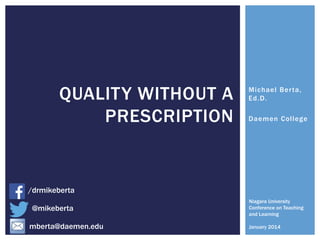Quality without a Prescription
- 1. Michael Berta, Ed.D. Daemen College QUALITY WITHOUT A PRESCRIPTION Niagara University Conference on Teaching and Learning January 2014 /drmikeberta @mikeberta mberta@daemen.edu
- 2. 3,000,000 3,500,000 4,000,000 4,500,000 5,000,000 5,500,000 6,000,000 6,500,000 7,000,000 Fall 2007 Fall 2008 Fall 2009 Fall 2010 Fall 2011 Online Course Enrollments Allen & Seaman (2008) (2009) (2010) (2011) (2012)
- 3. The Problem Quality Concerns Increased Oversight Inadequate Institutional Systems Course Delivery Unaddressed Rigid Quality Structures Austin, 2010; Battin-Little, 200; Endean, et. al., 2010; Forsyth, et. al., 2010; Hoskins, 2009; Kee Meng & Mayadas, 2010; Picciano, 2009; Pollocia & McAllister, 2009; Postek, et. al, 2010; P. S. Smith, 2011; Westerfelt, 2011; Wickersham & McElhany, 2010; Vardi, 2012
- 4. Quality evaluation processes for distance education do not account for the complex differences in pedagogical approaches across disciplines or institutions and do not support the variety of skill levels and needs amongst faculty. Endean et al., 2010; Forsyth et al., 2010; Picciano, 2009; Postek et al., 2010; P. S. Smith, 2011; Westerfelt, 2011
- 5. 5. Develop Framework 1. Create a Sample Case 3. Revise 2. Collect and Analyze 4. Repeat Formative Research Method (Reigeluth & Frick, 1999; Reigeluth, 2009)
- 6. RQ 1 RQ 2RQ 3 Appeal EffectivenessEase of Use
- 7. Pedagogical Flexibility Teaching and Learning Quality Support and Necessary Skills Framework Organization Comprehensiveness
- 8. Support for Quality ŌĆóFlexible ŌĆóEvolving Improved Efficiency ŌĆóReduced burden ŌĆóEasy to use Collaborative ŌĆóCommon Language ŌĆóDesigners and Faculty Globalization ŌĆóIncreased quality ŌĆóDemonstration of standards IMPLICATIONS FOR LEADERS CourseQŌäó
Editor's Notes
- #2: Welcome and Agenda Committee Introduction, Acknowledgements, and Thank You The Problem Research Methodology Findings RQ 1 - Appeal RQ 2 - Effectiveness RQ 3 ŌĆō Efficiency/Ease of Use Implications for Leaders WhatŌĆÖs Next Committee Questions References for Review
- #5: Growth 6.1mm Students in Fall 2010 (Allen & Seaman, 2011) MOOCs (Vardi, 2012) Quality Concerns Despite growth administrators and faculty continue to express concern about quality (Austin, 2010; Endean, Bin, & Ruo, 2010; Forsyth, Pizzica, Laxton, & Mahony, 2010; Hoskins, 2009; Kee Meng & Mayadas, 2010; Picciano, 2009; P. S. Smith, 2011; Westerfelt, 2011; Wickersham & McElhany, 2010) Quality is a concern throughout the Higher Education Sector (Harvey & Williams, 2010) Increased Oversight External stakeholders are demanding more oversight and regulations are tightening (P. S. Smith, 2011) Inadequate Systems Instructional quality usually falls to faculty but this creates disparity within the school (Smith, 2011) Traditional systems canŌĆÖt adequately address the quickly evolving field of online education (Endean, et. al., 2010; Smith, 2011) Technology-based systems would enhance the schools ability to deal with evolving and demanding quality issues (Postek, et. al, 2010; Smith, 2011) Course Delivery Unaddressed Sloan-C and Quality Matters address quality in distance education but fail to account for quality at the course delivery level (Battin-Little, 2009, Pollocia & McAllister, 2009; Westerfelt, 2011) Rigid Structures Evaluation instruments tend to be rigid and limit assessors (Forsyth, et. al., 2010) To encourage faculty to adopt quality measures instruments should be flexible and allow for variances while still assuring quality delivery (Forsyth et al., 2010; Picciano, 2009; P. S. Smith, 2011; Wickersham & McElhany, 2010)
- #6: Create a case in supporting the new instructional design framework. Collect and analyze formative data. Revise the instructional design framework. Repeat steps two and three until the research reaches a point of saturation. Fully develop the tentative instructional design framework The Formative Research study method is implemented with a group of participants in a collaborative experience to find and develop enhancements of instructional design theories, models, or frameworks (Reigeluth & Frick, 1999). The method is appropriately applied to curricular quality in higher education. Instructional quality is improved when instructors and supporting administration collaborate on solving issues related to course quality (Daukilas et al., 2008; Jordens & Zepke, 2009).









